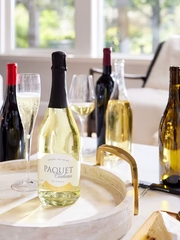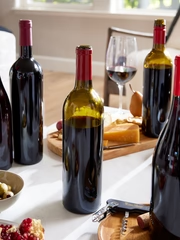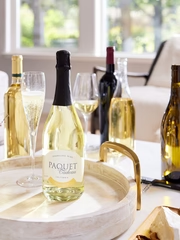When you think about gases and wine, most likely the tiny bubbles in a sparkling wine is the visual that springs to mind, but gases play various roles when it comes to wine. Gases present a lot of challenges that cannot be ignored in the creation of quality wines. Today, I will give you a little bit of detail describing their effects and uses in the process of winemaking.
 Argon ( Ar )
Argon ( Ar ) occurs naturally in the atmosphere and makes up around 1% of the air around us. Made when compressed air rapidly cools down, argon is a favorite gas of many winemakers. Inert gases such as argon are essential to manage the headspace of wine containers because they protect wine against oxidation and spoilage by yeast or bacteria. Argon is only 38% soluble in wine, which makes it an ideal protective gas, but it remains the most expensive to use.
 Carbon dioxide ( CO2 )
Carbon dioxide ( CO2 ) is one of the most common gases used in winemaking. It appears naturally during fermentation. Carbon dioxide provides a great shield during the youth of the wine – keeping oxygen at bay and creating the bubbles in sparkling wines.
In the “wine bible,”
The Taste of Wine by Emile Peynaud, the father of modern enology, describes CO
2 as a double-edged component, capable of making a wine sing or bite. Too little can render white wines flat from day one; too much can make reds harsh and tannic. At several key stages in its life, wine can contain anywhere from 500 mg/L to 1,800 mg/L of CO
2. For example, age-worthy reds should be bottled with no more than 100-200 mg/L but light, fruity reds could benefit from about 500 mg/L of CO
2. For trivia lovers, 4,000 mg/L is the legal limit for sparkling. Carbon dioxide can be found used in wineries as dry ice for gas tanks or for cooling fruit.
Oxygen ( O2 ) is at the top of every winemaker’s mind. Providing a boost of energy for the yeast during fermentation, this gas is feared later on, when it plays an enormous role during a wine’s ageing, racking and transferring from vessel to vessel.
Lees (the sediment of wine in the barrel) act as oxygen scavengers and can provide some protection against oxidation. I often embrace this technique. The “
sur lies” ageing gives wonderfully aromatic and full-bodied wines without a hint of oxidation.
To minimize oxygen intake during barrel ageing, cellar temperatures need to be maintained at 55-65°F and the humidity at 60-70 percent. If relative humidity is less than 60 percent, water will evaporate from the barrels, forming headspace and a vacuum. A tight seal in the barrel allows the wine to build structure, develop texture and use less sulfur dioxide ( SO
2 ) during ageing.
Nitrogen ( N2 ) is the easiest gas for a winery to use and generate. It is widely used during the entire life of the wine, all the way through bottling. Similar in density to air, it is used to blanket and replace oxygen anytime it is necessary in the winemaking process. Oxidation, spoilage, yeast and bacteria are lurking everywhere and nitrogen keeps it all at bay.


The Bulldog Pup is a widely used device in modern wineries. This device utilizes an inert gas to place gentle pressure on the wine without agitating it during transfer from the barrel. Nitrogen gas is preferred because it is cheap and the least soluble of all the gases. This method of transfer has the advantage of limited oxygen contact, making it very gentle on the wine. Winemakers also use spargers (porous stones) which are efficient in diffusing all types of gases in a tank during transfer.
In conclusion, gases are monitored carefully because of the tremendous influence they have on a wine’s stability. It would be very difficult to find a winery without a cylinder of argon or nitrogen around, due to the large role they and other gases play in the wine world.
 Argon ( Ar ) occurs naturally in the atmosphere and makes up around 1% of the air around us. Made when compressed air rapidly cools down, argon is a favorite gas of many winemakers. Inert gases such as argon are essential to manage the headspace of wine containers because they protect wine against oxidation and spoilage by yeast or bacteria. Argon is only 38% soluble in wine, which makes it an ideal protective gas, but it remains the most expensive to use.
Argon ( Ar ) occurs naturally in the atmosphere and makes up around 1% of the air around us. Made when compressed air rapidly cools down, argon is a favorite gas of many winemakers. Inert gases such as argon are essential to manage the headspace of wine containers because they protect wine against oxidation and spoilage by yeast or bacteria. Argon is only 38% soluble in wine, which makes it an ideal protective gas, but it remains the most expensive to use.
 Carbon dioxide ( CO2 ) is one of the most common gases used in winemaking. It appears naturally during fermentation. Carbon dioxide provides a great shield during the youth of the wine – keeping oxygen at bay and creating the bubbles in sparkling wines.
In the “wine bible,” The Taste of Wine by Emile Peynaud, the father of modern enology, describes CO2 as a double-edged component, capable of making a wine sing or bite. Too little can render white wines flat from day one; too much can make reds harsh and tannic. At several key stages in its life, wine can contain anywhere from 500 mg/L to 1,800 mg/L of CO2. For example, age-worthy reds should be bottled with no more than 100-200 mg/L but light, fruity reds could benefit from about 500 mg/L of CO2. For trivia lovers, 4,000 mg/L is the legal limit for sparkling. Carbon dioxide can be found used in wineries as dry ice for gas tanks or for cooling fruit.
Oxygen ( O2 ) is at the top of every winemaker’s mind. Providing a boost of energy for the yeast during fermentation, this gas is feared later on, when it plays an enormous role during a wine’s ageing, racking and transferring from vessel to vessel.
Lees (the sediment of wine in the barrel) act as oxygen scavengers and can provide some protection against oxidation. I often embrace this technique. The “sur lies” ageing gives wonderfully aromatic and full-bodied wines without a hint of oxidation.
To minimize oxygen intake during barrel ageing, cellar temperatures need to be maintained at 55-65°F and the humidity at 60-70 percent. If relative humidity is less than 60 percent, water will evaporate from the barrels, forming headspace and a vacuum. A tight seal in the barrel allows the wine to build structure, develop texture and use less sulfur dioxide ( SO2 ) during ageing.
Nitrogen ( N2 ) is the easiest gas for a winery to use and generate. It is widely used during the entire life of the wine, all the way through bottling. Similar in density to air, it is used to blanket and replace oxygen anytime it is necessary in the winemaking process. Oxidation, spoilage, yeast and bacteria are lurking everywhere and nitrogen keeps it all at bay.
Carbon dioxide ( CO2 ) is one of the most common gases used in winemaking. It appears naturally during fermentation. Carbon dioxide provides a great shield during the youth of the wine – keeping oxygen at bay and creating the bubbles in sparkling wines.
In the “wine bible,” The Taste of Wine by Emile Peynaud, the father of modern enology, describes CO2 as a double-edged component, capable of making a wine sing or bite. Too little can render white wines flat from day one; too much can make reds harsh and tannic. At several key stages in its life, wine can contain anywhere from 500 mg/L to 1,800 mg/L of CO2. For example, age-worthy reds should be bottled with no more than 100-200 mg/L but light, fruity reds could benefit from about 500 mg/L of CO2. For trivia lovers, 4,000 mg/L is the legal limit for sparkling. Carbon dioxide can be found used in wineries as dry ice for gas tanks or for cooling fruit.
Oxygen ( O2 ) is at the top of every winemaker’s mind. Providing a boost of energy for the yeast during fermentation, this gas is feared later on, when it plays an enormous role during a wine’s ageing, racking and transferring from vessel to vessel.
Lees (the sediment of wine in the barrel) act as oxygen scavengers and can provide some protection against oxidation. I often embrace this technique. The “sur lies” ageing gives wonderfully aromatic and full-bodied wines without a hint of oxidation.
To minimize oxygen intake during barrel ageing, cellar temperatures need to be maintained at 55-65°F and the humidity at 60-70 percent. If relative humidity is less than 60 percent, water will evaporate from the barrels, forming headspace and a vacuum. A tight seal in the barrel allows the wine to build structure, develop texture and use less sulfur dioxide ( SO2 ) during ageing.
Nitrogen ( N2 ) is the easiest gas for a winery to use and generate. It is widely used during the entire life of the wine, all the way through bottling. Similar in density to air, it is used to blanket and replace oxygen anytime it is necessary in the winemaking process. Oxidation, spoilage, yeast and bacteria are lurking everywhere and nitrogen keeps it all at bay.

 The Bulldog Pup is a widely used device in modern wineries. This device utilizes an inert gas to place gentle pressure on the wine without agitating it during transfer from the barrel. Nitrogen gas is preferred because it is cheap and the least soluble of all the gases. This method of transfer has the advantage of limited oxygen contact, making it very gentle on the wine. Winemakers also use spargers (porous stones) which are efficient in diffusing all types of gases in a tank during transfer.
In conclusion, gases are monitored carefully because of the tremendous influence they have on a wine’s stability. It would be very difficult to find a winery without a cylinder of argon or nitrogen around, due to the large role they and other gases play in the wine world.
The Bulldog Pup is a widely used device in modern wineries. This device utilizes an inert gas to place gentle pressure on the wine without agitating it during transfer from the barrel. Nitrogen gas is preferred because it is cheap and the least soluble of all the gases. This method of transfer has the advantage of limited oxygen contact, making it very gentle on the wine. Winemakers also use spargers (porous stones) which are efficient in diffusing all types of gases in a tank during transfer.
In conclusion, gases are monitored carefully because of the tremendous influence they have on a wine’s stability. It would be very difficult to find a winery without a cylinder of argon or nitrogen around, due to the large role they and other gases play in the wine world.





